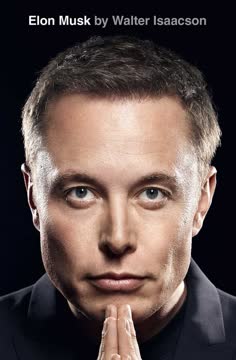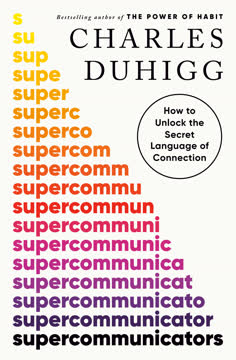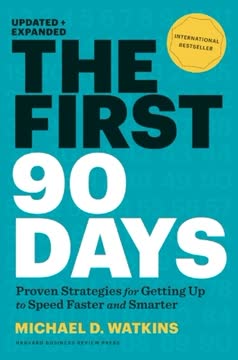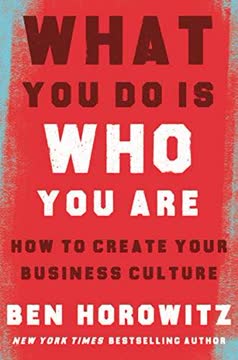Key Takeaways
1. Set a bold vision and make big strategic moves early and often
Boldness has genius, power, and magic in it.
Reframe the game. The best CEOs don't just raise aspiration levels; they change the definition of success. They look for intersections between market needs, company capabilities, and passion to create a compelling vision that goes beyond making money. This vision should inspire employees and provide a north star for decision-making.
Make big moves courageously. Research shows that CEOs who make multiple big strategic moves early in their tenure significantly outperform others. These moves typically include:
- Mergers, acquisitions, and divestitures
- Significant capital expenditures
- Productivity improvements
- Business model innovations
- Major resource reallocations
The best CEOs combine a clear long-term vision with the courage to make bold short-term moves, even in the face of uncertainty. They maintain conviction by being exceptional futurists, understanding risk-reward trade-offs, and acting like owners of the business.
2. Treat organizational culture and structure as critical business priorities
Culture is coded wisdom.
Find the "one thing" culturally. Rather than trying to change everything, excellent CEOs focus on the single most important cultural shift that will drive performance. They reshape the work environment to support this shift through role modeling, formal mechanisms, storytelling, and skill-building.
Design for "stagility". The best CEOs create organizational structures that balance stability and agility. They:
- Define clear accountabilities to avoid matrix-induced gridlock
- Connect the dots between silos and decision-making bodies
- Empower agile teams to drive innovation while maintaining a stable core
- Match talent to value-creating roles, not just hierarchical positions
By treating culture and structure as mission-critical priorities, top CEOs align their organizations to execute on strategy and adapt to change.
3. Build a high-performing leadership team focused on collaboration
Teamwork makes the dream work, but vision becomes a nightmare when the leader has a big dream and a bad team.
Create an ecosystem. Excellent CEOs carefully compose their leadership teams for complementary skills and diverse perspectives. They act fast but fairly when someone isn't the right fit, balancing consistency of character with adapting their leadership approach as needed.
Make the team the star. The best CEOs foster genuine teamwork by:
- Ensuring the team focuses on work only it can do collectively
- Establishing "first team" mindsets and behaviors
- Combining data, dialogue, and speed in decision-making
- Investing in team-building and feedback mechanisms
They also create a disciplined operating rhythm with the right cadence of meetings and reviews. By solving for team psychology first, excellent CEOs unlock higher performance across the organization.
4. Partner with the board to drive business success
Money is the currency of transactions. Trust is the currency of interactions.
Build a foundation of trust. The best CEOs proactively build strong relationships with board members, especially the chair, through radical transparency and consistent delivery on commitments. They reach out to individual directors to understand their perspectives and tap their expertise.
Help directors help the business. Excellent CEOs go beyond fulfilling fiduciary duties to actively engage the board as strategic partners. They:
- Clearly delineate board and management roles
- Educate directors on the business and industry trends
- Expose the board to key leaders and talent
- Encourage board renewal and diversity of skills
By focusing board meetings on forward-looking topics and balancing oversight with insight, top CEOs leverage their boards as a powerful asset for the company.
5. Engage stakeholders by understanding their motivations and creating shared value
There's no harm in hoping for the best as long as you're prepared for the worst.
Start with "why?". The best CEOs deeply understand the motivations of each stakeholder group. They maintain a consistent narrative across constituencies while tailoring engagement approaches. They also look for opportunities to create shared value that benefits multiple groups simultaneously.
Shape strong relationships. Excellent CEOs:
- Contain time spent externally to ~30% through disciplined prioritization
- Harvest new ideas from every interaction
- Prepare thoroughly for crises through regular stress-testing
- Show personal resilience in the face of criticism and setbacks
By proactively engaging diverse stakeholders and deftly handling crises, top CEOs build credibility and support for their agendas.
6. Lead with purpose and make a positive societal impact
Definiteness of purpose is the starting point of all achievement.
Clarify your company's societal "why?". The best CEOs articulate how their company makes a positive impact beyond shareholder returns. They embed this purpose into core operations rather than treating it as a side initiative.
Use strengths to make a difference. Excellent CEOs:
- Leverage company capabilities to address environmental and social issues
- Set ambitious sustainability targets linked to the business model
- Take stands on societal issues when warranted, guided by company values
- Create mechanisms for employees to contribute their skills to worthy causes
By authentically pursuing a higher purpose, top CEOs inspire their organizations, attract talent and customers, and future-proof their businesses.
7. Develop personal discipline and humility to sustain long-term success
Doing is never enough if you neglect being.
Manage time and energy. The best CEOs treat the job as a series of sprints rather than a marathon. They:
- Keep a "tight but loose" schedule with time for reflection
- Compartmentalize to be fully present in each interaction
- Build in recovery periods to avoid burnout
- Tailor their support staff to enable peak performance
Live your "to-be" list. Excellent CEOs focus not just on what they do, but on who they are as leaders. They:
- Act consistently with their values and strengths
- Adapt their leadership style to what the company needs
- Embrace feedback and continuous personal growth
- Provide hope and confidence even in difficult times
Stay humble. The best CEOs maintain perspective through practices like:
- Never making it about themselves
- Embracing servant leadership
- Creating a diverse "kitchen cabinet" of advisors
- Displaying genuine gratitude for the opportunity to lead
By mastering personal effectiveness, top CEOs sustain their impact over the long haul.
8. Master all aspects of the CEO role to drive exceptional performance
Your big picture will never be a masterpiece if you ignore the tiny brush strokes.
Be a corporate decathlete. The CEO role requires excellence across multiple dimensions:
- Setting direction
- Aligning the organization
- Mobilizing leaders
- Engaging the board
- Connecting with stakeholders
- Managing personal effectiveness
While CEOs may have signature strengths, the best perform at a high level across all areas.
Evolve your approach. Top CEOs adapt their focus and tactics as the business situation changes and their capabilities grow. They maintain core principles while flexing their style to meet new challenges.
Filter signal from noise. As the pace of change accelerates, excellent CEOs distinguish between enduring truths about leadership and fleeting trends. They anticipate how their role may evolve to become more:
- Ethically accountable
- Diverse and inclusive
- Resilient to pressure
- Impactful on broader society
By mastering the full spectrum of CEO responsibilities and continually growing in the role, the best leaders drive sustained, exceptional performance.
Last updated:
FAQ
What's CEO Excellence about?
- Focus on CEO Mindsets: CEO Excellence by Carolyn Dewar, Scott Keller, and Vikram Malhotra explores the six mindsets that distinguish top CEOs from their peers.
- Key Responsibilities: It identifies six key responsibilities of CEOs, including setting direction and aligning the organization, and examines the mindsets that drive excellence in these areas.
- Practical Insights: The book offers actionable insights and frameworks for current and aspiring leaders, making it relevant for anyone in a leadership role.
Why should I read CEO Excellence?
- Learn from the Best: The book provides insights from interviews with over sixty top CEOs, offering a unique perspective on effective leadership.
- Framework for Success: It presents a structured framework for understanding the complexities of the CEO role, aiding leaders in navigating their challenges.
- Timely and Relevant: The lessons are particularly relevant for leaders facing uncertainty and complexity in today's rapidly changing business environment.
What are the key takeaways of CEO Excellence?
- Six Mindsets for Success: The book emphasizes six mindsets that separate excellent CEOs from average ones, such as being bold and treating the soft stuff as hard.
- Importance of Culture: A strong organizational culture is crucial for executing strategy successfully, and CEOs must treat cultural change with the same rigor as financial changes.
- Focus on Accountability: The best CEOs emphasize accountability within their teams, ensuring roles are clearly defined to align efforts towards common goals.
What are the best quotes from CEO Excellence and what do they mean?
- “Excellence is never an accident.”: This quote underscores that successful leadership results from deliberate actions and mindsets, not mere luck.
- “Culture eats strategy for breakfast.”: It highlights the importance of organizational culture in achieving strategic goals, stressing that without a supportive culture, strategies may fail.
- “You can’t cross a chasm in two small jumps.”: This emphasizes the need for bold, decisive actions in leadership, advocating for significant moves to achieve substantial results.
What are the six mindsets that distinguish the best CEOs from the rest?
- Be Bold: Successful CEOs take calculated risks and make bold decisions that drive their organizations forward.
- Treat the Soft Stuff as Hard: This mindset emphasizes the importance of emotional intelligence, culture, and relationships in leadership.
- Focus on the Future: Great CEOs maintain a forward-looking perspective, ensuring strategies align with future trends and opportunities.
What are the six key responsibilities of a CEO as outlined in CEO Excellence?
- Setting Direction: CEOs must define the vision and strategy for the organization, aligning it with market opportunities and stakeholder expectations.
- Aligning the Organization: Effective CEOs create alignment across the organization by fostering a strong culture and ensuring commitment to company goals.
- Mobilizing Through Leaders: CEOs empower their leadership teams to drive performance and innovation, nurturing talent and creating a thriving environment.
How do the best CEOs engage with their boards according to CEO Excellence?
- Radical Transparency: The best CEOs practice radical transparency with their boards, sharing both good and bad news openly to build trust.
- Strong Relationships: Establishing a strong relationship with the board chair and individual directors is crucial for effective board engagement.
- Expose Management to the Board: CEOs ensure board members have direct access to management, allowing for open dialogue and deeper insights.
What does CEO Excellence say about the importance of culture in organizations?
- Culture Drives Performance: The book emphasizes that culture is a critical factor in executing strategy successfully, aligning employees with organizational goals.
- Treating Soft Stuff as Hard: CEOs must treat cultural change with the same rigor as financial changes, integrating cultural values into everyday practices.
- Building Trust: A positive culture fosters trust among employees, essential for collaboration and innovation.
How can CEOs ensure their teams are high-performing according to CEO Excellence?
- Define High-Value Roles: CEOs should clearly define roles that drive the most value and ensure they are filled with the right talent.
- Act Fast but Fair: When team members are not performing, the best CEOs take action quickly but fairly, maintaining morale and trust.
- Invest in Team Building: Regular investment in team-building activities fosters collaboration and trust among team members.
What is the concept of "stagility" in CEO Excellence?
- Combination of Stability and Agility: Stagility refers to balancing stable structures with agile processes for quick adaptation to change.
- Designing for Flexibility: The best CEOs create organizations that are both strong and flexible, enabling effective responses to market changes.
- Continuous Improvement: Organizations embodying stagility are more likely to innovate and improve continuously, leading to better performance.
How do CEOs manage their personal effectiveness according to CEO Excellence?
- Prioritize Time and Energy: Effective CEOs allocate time to high-impact activities and ensure recovery periods to maintain energy levels.
- Adapt Leadership Style: CEOs should be flexible in their leadership approach, adapting to organizational needs while staying true to core values.
- Seek Continuous Growth: The best CEOs pursue feedback and learning opportunities to improve their leadership skills, understanding personal development as an ongoing journey.
What role does humility play in effective leadership according to CEO Excellence?
- Grounded Perspective: Humility allows CEOs to maintain a realistic view of their role, recognizing success as a result of teamwork.
- Servant Leadership: Humble leaders prioritize team and stakeholder needs, fostering a culture of support and empowerment.
- Open to Feedback: Humility encourages leaders to seek and accept feedback, essential for personal and organizational growth.
Review Summary
CEO Excellence receives mostly positive reviews for its comprehensive analysis of effective CEO practices. Readers appreciate the well-researched content, practical advice, and insightful examples from top executives. The book's structure and clarity are praised, making it accessible for various leadership levels. Some criticize the lack of groundbreaking ideas and overconfidence in presentation. While primarily focused on large corporate CEOs, many find valuable leadership lessons applicable to different roles. Overall, it's considered a useful resource for understanding high-level executive responsibilities and strategies.
Similar Books










Download PDF
Download EPUB
.epub digital book format is ideal for reading ebooks on phones, tablets, and e-readers.




